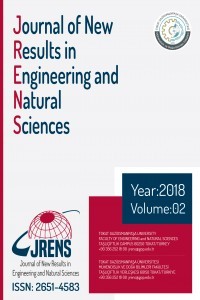Malzeme Sınıflandırma Prototip Sisteminin Tasarımı ve Uygulaması
Görüntü işleme, Labview, Endüstriyel Robot Manipülatör, Üniversal Tutucu
Design and Experimental Applications of Material Classification Prototype System
Image Processing, Labview, Industrial Robot Manipulator, Universal Gripper,
___
- [1] John R. Amend, Brown E., Rodenberg N., Jaeger H. M., Lipson H., “A Positive Pressure Universal Gripper Based on the Jamming of Granular Material,” IEEE Transactions on Robotics, vol. 28 (2), pp. 341-350, April 2012.
- [2] Shin I. S., Nam S., Geun Yu H., Roberts R. G., Moon S. B., “Conveyor visual tracking using robot vision,” Florida Conference on Recent Advances in Robotics, 2006, p. 1-5.
- [3] Reddy P. V. P., Satya Suresh V. V. N., “A Review on Importance of Universal Gripper in Industrial Robot Applications” International Journal of Mechanical Engineering and Robotics Research, vol. 2 (2), pp. 255-264, April 2013.
- [4] Brown E., Rodenberg N., Amend J., Mozeikac A., Steltzc E., Zakind M. R., Lipson H., Jaegera H. M., “Universal robotic gripper based on the jamming of granular material,” PNAS vol. 107 (44), pp. 18809–18814, Nov. 2010.
- [5] Fajardo P. R. B., Genoves V. F. S., Libiran J. G., Ortiz R. B. T., Torres K. V. B., Serrano K. K. D., “Development of a Variable Negative Pressure Jamming Gripper through Visual Object Size Classification and Artificial Neural Network,” Region 10 Conference (TENCON) - Proceedings of the International Conference IEEE 2016, pp. 2081- 2085.
- [6] Beyaz A., “Labview Platformunda Video Analizi ile Tarımsal Ürün Boyutu Belirleme,” Journal of Agricultural Faculty of Gaziosmanpasa University, vol. 33, pp. 1-9. August 2016
- [7] Pal Singh A., Julka N., “Screw classification using machine vision,” International Journal of Electronics and Communication Technology, vol. 2 (1), pp. 31-33, 2011.
- [8] Changalasetty S. B., Badawy A. S., Ghribi W., Ashwi H. I., Al-Shehri1 A. M., Al-Shehri A. D. A., Thota L. S., Medisetty R., “Identification and classification of moving vehicles on road,” Computer Engineering and Intelligent Systems, vol. 4 (8), pp. 1-12, 2013.
- [9] Islam R. U., Iqbal J., Manzoor S., Khalid A., Khan S., An “Autonomous Image-guided Robotic System Simulating Industrial Applications,” Proc. of the 2012 7th International Conference on System of Systems Engineering IEEE, 2012, pp. 344-349.
- [10]Şenel F. A., Çetişli B., “Götüntü işleme ve beş eksenli robot kol ile üretim bandında nesne denetimi,” Pamukkale University Journal of Engineering Sciences, 2015, pp. 158-161.
- [11]Şenses U., Sunar O., Korçak E. B., Gemalmayan N., Erol S., Taplamacıoğlu M. C. (2017) EMO homepage [Online] Available: http://www.emo.org.tr/ekler/314e8e9133de8ef_ek.pdf
- Yayın Aralığı: Yılda 2 Sayı
- Başlangıç: 2013
- Yayıncı: Tokat Gaziosmanpaşa Üniversitesi
Kuantum Bilgisayarlarının Gerçekleştirildiği Sistemler
Mehpeyker KOCAKOÇ, Recep TAPRAMAZ
Jet Boyama Makinesinin Termal Modeli
Lütfullah DAĞKURS, İsmail İŞERİ
Cebrail ÇİFLİKLİ, Bilgin YAZLIK
Karınca Kolonisi Algoritması ile Yazılım Proje Takvimi Oluşturma
Otomatik Ayarlamalı Sinir Hücresi ile Adaptif Kesir Dereceli PID Kontrolör Tasarımı
Hüseyin ARPACI, Ömerül Faruk ÖZGÜVEN, Mehmet Serhat CAN
Akıllı Şebekelerde Güvenli Haberleşme Tabanlı Güç Akışı Analizi
Metin VARAN, Sajia HAİDARY, İsmail ÖYLEK, Özkan CANAY
Belirli Halkalar ve Grup Kodlar
Quasi-Cyclic Codes over the Field Fp
KOMPOZİT VE KUTU PROFİLİN DARBE KUVVETİ ALTINDAKİ DAVRANIŞI
Elif AĞCAKOCA, Zeynep YAMAN, Yunus Emre YAZICI
Kutrit Sistemlerde Hadamard Geçidi ile Yapılan Bazı İşlemler
